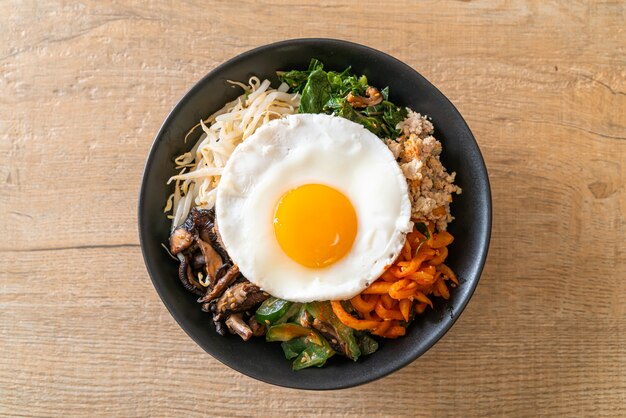Bibimbap is a flavorful and vibrant Korean dish that’s become popular worldwide for its delightful mix of textures and flavors. The name bibimbap translates to “mixed rice,” and it’s traditionally served with a variety of vegetables, protein, and a spicy, tangy sauce. Here’s how to make this hearty and satisfying dish right at home.
Ingredients:
- For the Rice:
- 2 cups of short-grain or medium-grain white rice
- 4 cups of water
- For the Vegetables:
- 1 cup spinach, blanched
- 1 medium carrot, julienned
- 1 zucchini, julienned
- 1/2 cup shiitake mushrooms, sliced (or any mushrooms of choice)
- 1 small cucumber, thinly sliced (optional)
- For the Protein:
- 1/2 lb ground beef (or chicken, tofu, or a fried egg as alternatives)
- 2 tablespoons soy sauce
- 1 tablespoon sesame oil
- 1 tablespoon sugar
- 1 clove garlic, minced
- 1 teaspoon sesame seeds
- For the Sauce:
- 2 tablespoons gochujang (Korean red pepper paste)
- 1 tablespoon sesame oil
- 1 tablespoon sugar
- 1 tablespoon rice vinegar
- 1 tablespoon water
- 1 teaspoon garlic, minced
- 1 teaspoon sesame seeds
- For Garnish:
- 1 egg (fried sunny side up or your preferred style)
- Sesame seeds
- Chopped green onions
Instructions:
- Cook the Rice:
Start by cooking the rice. Rinse it thoroughly to remove excess starch, then cook it in a rice cooker or on the stovetop with the 4 cups of water until it’s tender and fluffy. - Prepare the Vegetables:
- Spinach: Blanch the spinach in boiling water for 1 minute, then rinse it under cold water. Squeeze out any excess moisture and season with a little sesame oil and salt.
- Carrots: Julienne the carrots and lightly sauté them in a pan with a touch of sesame oil for about 2-3 minutes, keeping them crisp.
- Zucchini: Julienne the zucchini and sauté it with a little oil for 2-3 minutes until tender.
- Mushrooms: Sauté the mushrooms in sesame oil until they release their moisture and become tender (about 4 minutes).
- Prepare the Protein:
- For the ground beef: Heat a pan over medium-high heat and add the ground beef. Break it apart with a spatula as it cooks. Once browned, add soy sauce, sesame oil, sugar, and minced garlic. Stir well and cook for another 2 minutes, then set aside.
- For a fried egg: Fry an egg in a small pan with a little oil until the white is set but the yolk remains runny. You can also opt for scrambled eggs if you prefer.
- Make the Sauce:
In a small bowl, whisk together the gochujang, sesame oil, sugar, rice vinegar, water, minced garlic, and sesame seeds until smooth. Adjust the seasoning to taste, adding more sugar or gochujang for sweetness or heat. - Assemble the Bibimbap:
In a large bowl, place the cooked rice as the base. Arrange the cooked vegetables (spinach, carrots, zucchini, and mushrooms) on top of the rice in separate sections. Add the cooked ground beef (or your choice of protein) and top with the fried egg. Drizzle the gochujang sauce over the dish and garnish with sesame seeds and chopped green onions. - Mix and Serve:
To enjoy bibimbap, mix all the ingredients together, ensuring the spicy sauce is well-distributed. The heat from the rice will slightly melt the egg yolk, adding richness to the dish. Serve immediately and enjoy!
Tips for Making Bibimbap:
- Rice: For the best texture, use short-grain rice, which is stickier and helps hold the ingredients together.
- Vegetables: Feel free to get creative with the veggies! Traditional bibimbap includes bean sprouts, but you can add any vegetable you like, such as bell peppers, radishes, or cabbage.
- Gochujang: The gochujang sauce is what gives bibimbap its signature spicy-sweet flavor, so don’t skip this essential ingredient. You can find it in most Asian grocery stores or online.
- Egg: The fried egg adds a creamy texture that’s essential to bibimbap. If you’re vegan, you can skip the egg and opt for tofu or other plant-based proteins instead.
Making bibimbap at home is a fun and rewarding experience, and it allows you to customize the ingredients to suit your preferences. Whether you enjoy it with beef, chicken, tofu, or just vegetables, bibimbap is a versatile dish that delivers a rich combination of flavors and textures. Plus, the colorful presentation makes it as visually appealing as it is delicious!








